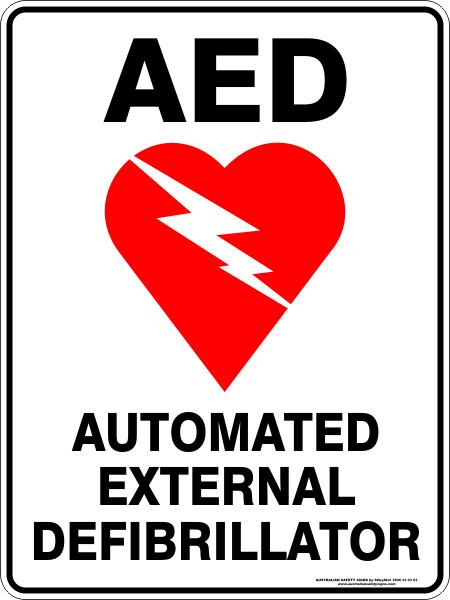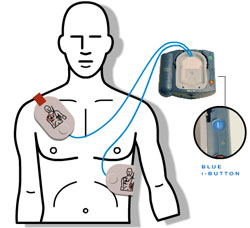The Canadian Red Cross is proud to release the new Basic Life Support (BLS) program – the only Canadian researched and developed program, and the most up-to-date on the market. Our BLS program incorporates the latest evidence-based science and research; aligns with industry standards; and meets legislative requirements.
COMING SOON! Psychological First Aid Courses
How to use an Automated External Defibrillator (AED)
What is an AED?
An Automated External Defibrillator (AED) is an extremely invaluable tool to use in the event of a cardiac arrest and can certainly be the difference between life and death for the victim. The basic function of an AED is to deliver a life-saving shock to the heart of the victim in order to get it beating on its own again. However, an AED will be most effective if used within a few minutes following the cardiac arrest. Thus, knowing how to use the AED ahead of time and having it readily available are very important factors in a successful rescue.
How do I know the person is in cardiac arrest?
A person in cardiac arrest will not be breathing normally. This is a sign that the heart has stopped beating. If a person is experiencing agonal respirations, this is considered abnormal breathing and is actually a sign the heart is not beating (cardiac arrest).
Start CPR immediately and send someone to call 9-1-1 and retrieve the AED. Once the AED is on scene follow these steps:
1. Apply the AED pads. Quickly.
AED pads must be placed directly on a bare and dry chest. There should be a small kit that comes with the AED containing a pair of scissors, razor and towel/cloth. These must be used first in that order. Remove all clothing away from the chest using the scissors to cut straight up the middle of the garments covering their chest. Next, use the razor (if necessary) to shave any hair away from the locations where the pads will be placed. Lastly, dry any moisture from the chest using the towel/cloth.
The pads will then be placed diagonally across the chest. Simply follow the diagram on the pads as to where they should be placed. For an adult, one pad will be applied on the right side of the chest and the other on the left side of the lower ribcage. For a child or baby, one pad will be placed in the centre of the chest and the other in the centre of the back. See below.
The pads must have a minimum spacing of approximately 2.5 cm or 1 in. Same goes for clearance from an implanted medical device such as a pacemaker. If you see a scar with a raised lump under the skin, assume it to be an implanted medical device.
Adult placement.
Child/Baby placement
2. Turn on the AED.
Press the power button. From here, the AED is going to walk you through the remainder of the rescue. Listen carefully to what is begins saying. Although there are a number of different AEDs on the market, they will all follow the same general steps:
1) Analysis --> 2) Shock/No Shock --> 3) CPR --> 4) Repeat
During "Analysis" the AED is checking to see if, in fact, the person's heart rhythm is shockable. The AED will tell you not to touch the victim. Wave your hands over them and say aloud, "Everyone clear!" It is important nobody is touching the victim at this stage as it is possible the AED picks up that person's heart rhythm, prompting a "No shock".
ZOLL AED Plus
After analyzing the victim's heart rhythm, the AED will either prompt, "Shock advised" or, "No shock advised". If a shock is advised the AED will then either begin counting down from 3 (fully-automatic AED) or prompt you to press the shock button (semi-automatic AED). The fully-automatic AED will provide you 3-seconds to stand clear and then deliver the shock itself. Be sure to, once again, wave your hands over the victim and say aloud, "Everyone clear!" Alternatively, the semi-automatic AED will prompt you to, "Press the shock button now." Press the button immediately after waving your hands over the victim and saying, "Everyone clear!"
Once the shock has been delivered, the AED will prompt you to begin CPR. Begin CPR immediately and continue until the AED tells you to stop.
3. Continue CPR following the AED's prompts.
The AED will prompt you through your CPR cycles. Some AEDs provide more feedback than others. All AEDs will beep at the rate at which you should be delivering chest compressions, this is a standard feature. Some AEDs will also provide feedback as to whether or not you are pushing hard enough. Listen to these prompts and continue doing what the AED is saying.
After 2 minutes of CPR has elapsed, the AED will, once again, go back through the steps of analysis, shock or no shock and then prompt you to perform CPR. Continue following these prompts until either the person is breathing normally or EMS arrive and take over.
LIMITED TIME OFFER! 10% OFF ALL TRAINING IN KITCHENER-WATERLOO
CPR level HCP. Do you need it?
Blended Learning: The Future of First Aid Training is Here
NEW! Waterloo First Aid Training Location
Summer Safety Series: Water Safety
In our previous two installments of the Summer Safety Series, we talked about heat exhaustion and heat stroke. Cooling off in the water is a great way to avoid these other two heat related illnesses but it can pose some very real dangers. The risk of water-related injury or death when in, on or near the water is far greater than perceived. However, being aware of these dangers is a great way to stay safe and enjoy your time in the water this summer. Here are some tips to ensure you stay safe while enjoying the water this summer:
Partner up
Swimming with a partner is one of the best, and easiest practices in staying safe around the water. Even the most experienced swimmers can become tired or experience muscle cramps while swimming. In a situation like this your partner can offer you assistance while also calling out for further help.
Check water currents
Water currents can be powerful enough to sweep away those who enter them. Before entering the water, take in to consideration how fast the water is flowing. If you think the water is flowing quickly or are unsure, stay out of the water. Check with your local conservation authority for river flows before heading out in to the water. If swimming at a beach, look for flags indicating the power of undertows or ask a lifeguard if one is present.
Do not dive in unknown waters
Diving head first into the water should only be done if and when the depth of the water is well known. Although you may not be able to see the bottom, this does not guarantee the water is deep enough to dive. There may be hidden dangers like rocks hidden by murky waters. Oppositely, just because you can see the bottom, the actual depth of the water can be deceiving when looking from above.
Supervise children
Children should never be left unsupervised in or near water. It only takes a few seconds for a child to drown in the absence of an adult. Any time you need to leave the children unsupervised, make sure they are well clear of the water. It takes only a few centimetres of water for a child or baby to drown. For every drowning death, there are numerous non-fatal near-drownings that require hospitalization.
Swim within the buoys
When there are buoys indicating a designated swimming area, do not stray from their confines. Outside of swimming area may be hidden dangers such as marine life, rocks, or boating traffic. The water is just as nice inside the buoys as it is outside!
Learn how to tend to drowning and other conditions by taking a first aid and CPR course! For a list of all available courses and dates click here.
To stay current with more lifesaving skills or to receive updates from Save-A-Life sign up for our quarterly newsletter by clicking here.
Summer Safety Series: Heat Stroke
Next up in our Summer Safety Series is Heat Stroke. Heat Stroke, sometimes referred to as sun stroke, is much more dangerous than heat exhaustion and it is important to be able to distinguish between the two. Heat stroke can be life-threatening and is a condition in which a person's body is no longer able to regulate it's own core temperature (they stop sweating).
Summer Safety Series: Heat Exhaustion
Summer is here... finally, and its time to enjoy it! After a long cold winter and rainy spring, it is finally time to get outside to enjoy the warm weather and sunshine. It is important, however, to ensure you do so safely and responsibly. In this series we will go over various heat related emergencies and illnesses and how to avoid/treat them. In our first installment, we will cover heat exhaustion.
Winter is Here. Are you prepared for all it can throw at you?
We all need to take time to enjoy the great outdoors and especially in the winter. Winter, however, brings with it additional risks that we need to be aware of and prepare for.
We, not only, need to prepare for such risks, but also, we need to be able to recognize when somebody is suffering from the cold. Can you recognize a cold related emergency when you see one?
Hypothermia
Hypothermia is a cold related emergency in which the person's core body temperature begins to drop below normal (37 degrees celsius). When this happens, the person's health is at risk and their life can possibly be threatened.
Mild Hypothermia - The person is in no grave danger. They will be cold and shivering at this point, although their core temperature stays relatively normal (it can possibly slightly below normal). The person may have some numbness or lack of sensation in their extremities, especially their fingers and toes.
Moderate Hypothermia - The person is becoming increasingly at risk for developing sever hypothermia. At this point their core temperature begins to fall. The numbness they are experiencing in their extremities may begin to make its way in to larger body parts. The person will be shivering quite rapidly. This can affect their behaviour, judgment and coordination.
Severe Hypothermia - The person is in grave danger. They need to receive advanced medical care. Their core body temperature will drop below 30 degrees celsius and they stop shivering and complaining of the cold. Their behaviour and judgement will still be impaired and may actually cause unconsciousness.
Caring for Hypothermia - Warm the person up gradually. Warming a person too rapidly can cause dangerous heart arrhythmias. If it is severe hypothermia call 911 immediately.
Learn how to tend to hypothermia and other conditions by taking a first aid and CPR course. For a list of all available courses and dates click here.
To stay current with more lifesaving skills or to receive updates from Save-A-Life sign up for our quarterly newsletter by clicking here.
Learn how to Save-A-Life today!
















